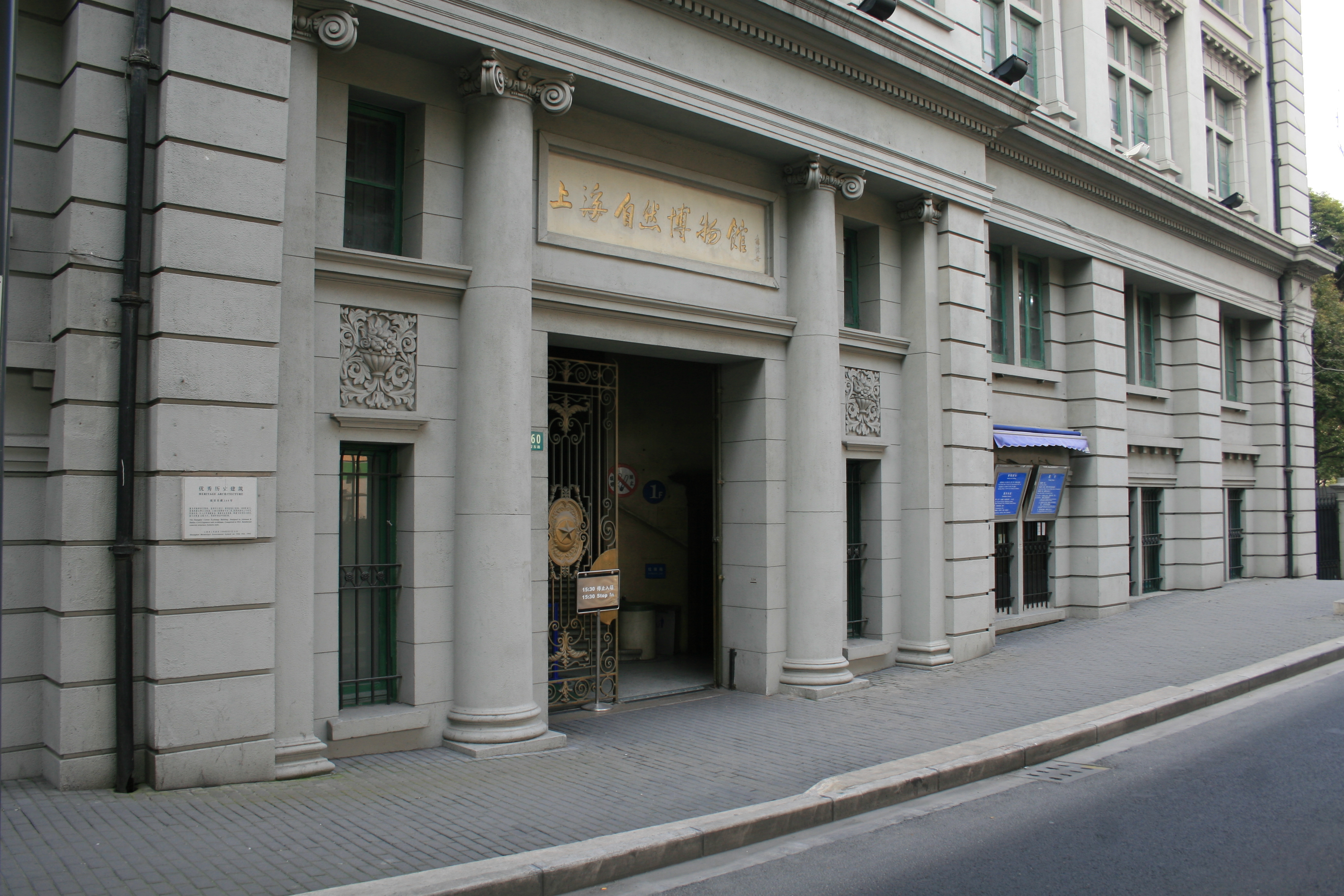Shanghai Natural History Museum on:
[Wikipedia]
[Google]
[Amazon]
The Shanghai Natural History Museum (; Shanghainese: Zånhae Zyzoe Pohvehguoe) is a
 The museum was established in 1956 in the Shanghai Cotton Exchange Building, a classical British structure built in 1923. It was located at 260 East Yan'an Road in Huangpu District, near the intersection of South Henan Road. It was designated a Heritage Building by the Shanghai Municipal Government in 1994. However, the Yan'an Elevated Road has since been constructed within meters in front of the building.
The new 44,517 square-meter building is in the Jing'an Sculpture Park. Opened to the public in 2015, the Shanghai Natural History Museum has moved to the new location.
The museum was established in 1956 in the Shanghai Cotton Exchange Building, a classical British structure built in 1923. It was located at 260 East Yan'an Road in Huangpu District, near the intersection of South Henan Road. It was designated a Heritage Building by the Shanghai Municipal Government in 1994. However, the Yan'an Elevated Road has since been constructed within meters in front of the building.
The new 44,517 square-meter building is in the Jing'an Sculpture Park. Opened to the public in 2015, the Shanghai Natural History Museum has moved to the new location.
Shanghai Natural History Museum — Some photos
{{authority control 1956 establishments in Shanghai Buildings and structures completed in 1923 Museums established in 1956 Museums in Shanghai Natural history museums in China Jing'an District
museum
A museum is an institution dedicated to displaying or Preservation (library and archive), preserving culturally or scientifically significant objects. Many museums have exhibitions of these objects on public display, and some have private colle ...
dedicated to natural history
Natural history is a domain of inquiry involving organisms, including animals, fungi, and plants, in their natural environment, leaning more towards observational than experimental methods of study. A person who studies natural history is cal ...
in the city of Shanghai
Shanghai, Shanghainese: , Standard Chinese pronunciation: is a direct-administered municipality and the most populous urban area in China. The city is located on the Chinese shoreline on the southern estuary of the Yangtze River, with the ...
. It is one of the largest museums of natural sciences in China. Formerly housed in the Shanghai Cotton Exchange Building, the museum was moved to a purpose-built site in the Jing'an Sculpture Park in 2015.
Location
 The museum was established in 1956 in the Shanghai Cotton Exchange Building, a classical British structure built in 1923. It was located at 260 East Yan'an Road in Huangpu District, near the intersection of South Henan Road. It was designated a Heritage Building by the Shanghai Municipal Government in 1994. However, the Yan'an Elevated Road has since been constructed within meters in front of the building.
The new 44,517 square-meter building is in the Jing'an Sculpture Park. Opened to the public in 2015, the Shanghai Natural History Museum has moved to the new location.
The museum was established in 1956 in the Shanghai Cotton Exchange Building, a classical British structure built in 1923. It was located at 260 East Yan'an Road in Huangpu District, near the intersection of South Henan Road. It was designated a Heritage Building by the Shanghai Municipal Government in 1994. However, the Yan'an Elevated Road has since been constructed within meters in front of the building.
The new 44,517 square-meter building is in the Jing'an Sculpture Park. Opened to the public in 2015, the Shanghai Natural History Museum has moved to the new location.
Collections and exhibits
The museum has a collection of 240,000 samples, including over 62,000 pieces of animal specimens, 135,000 plant specimens, 700 specimens of theStone Age
The Stone Age was a broad prehistory, prehistoric period during which Rock (geology), stone was widely used to make stone tools with an edge, a point, or a percussion surface. The period lasted for roughly 3.4 million years and ended b ...
, and 1,700 specimens of minerals. There are also rare species which cannot be found elsewhere outside China, such as a Yellow River
The Yellow River, also known as Huanghe, is the second-longest river in China and the List of rivers by length, sixth-longest river system on Earth, with an estimated length of and a Drainage basin, watershed of . Beginning in the Bayan H ...
mammoth
A mammoth is any species of the extinct elephantid genus ''Mammuthus.'' They lived from the late Miocene epoch (from around 6.2 million years ago) into the Holocene until about 4,000 years ago, with mammoth species at various times inhabi ...
, a giant salamander
Salamanders are a group of amphibians typically characterized by their lizard-like appearance, with slender bodies, blunt snouts, short limbs projecting at right angles to the body, and the presence of a tail in both larvae and adults. All t ...
, a giant panda, and a Yangtze alligator.
The largest exhibit is a 140-million-year-old dinosaur
Dinosaurs are a diverse group of reptiles of the clade Dinosauria. They first appeared during the Triassic Geological period, period, between 243 and 233.23 million years ago (mya), although the exact origin and timing of the #Evolutio ...
skeleton of '' Mamenchisaurus hochuanensis'' Young et Zhao from Sichuan Province, which is over four stories high. The museum also has two mummies and several human embryos.
See also
* List of museums in ChinaReferences
External links
* *Shanghai Natural History Museum — Some photos
{{authority control 1956 establishments in Shanghai Buildings and structures completed in 1923 Museums established in 1956 Museums in Shanghai Natural history museums in China Jing'an District